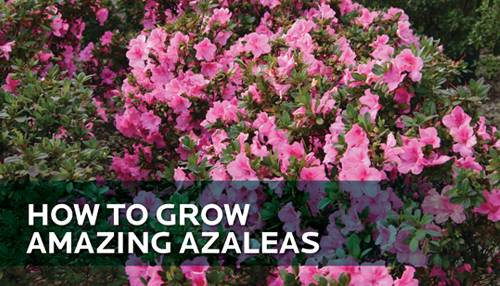How to Grow Amazing Azaleas
- Font size: Larger Smaller
- Hits: 19450
- 0 Comments
- Bookmark
I first fell for azaleas watching the Masters Golf Tournament every April. The landscaped areas of Augusta National in Georgia are overflowing with exquisite azaleas that pop on camera and in person. Sure, Augusta has professionals tending their azaleas but home gardeners can get the look with repeat super bloomer azalea varieties - Always Azaleas™ in Smart & Stylish Shrubs™ from the HGTV HOME Plant Collection.
Azaleas are easily some of the most rewarding evergreen shrubs you can add to your landscape. With showy blooms, color varieties and that beautiful massed effect that multiple plants create, azaleas are landscape stars. Azaleas are actually in the genus rhododendron and originated in Asia centuries ago where Buddhist monks tended the exotic shrubs.
For years, we associated azaleas with April blooming as harbingers of spring but breeders discovered in the 1990s that combining spring bloomers with summer blooming varieties from Asia would yield three blooming periods – spring, summer and fall. These repeat super bloomers are hardy performers that not only put on a big show but are also low maintenance and hardy in select growing zones, even through cold winters.
Where to Plant Azaleas
Azaleas thrive in southern or southeastern exposures close to a structure. Proximity to your home provides both wind and cold protection. Azaleas like 4 to 6 hours of morning sun along with some afternoon shade so planting them close to a grove of trees is ideal. Our family created an azalea garden next to a backyard patio and pergola several years ago with both in-ground and container azaleas that are repeat bloomers. We started with extra-large plastic containers to accommodate years of growth and the azaleas we planted have grown substantially each and every year. Through the years, we discovered that more soil volume in the container = more blooms, for impressive masses of gorgeous color.
How to Plant, Feed and Fertilize
When planting azaleas either in the ground or in containers, dig a hole twice the size of the root ball. Place the azalea in the hole and keep the top of the root ball level with the ground. Backfill with peat moss and dirt or top soil. Water thoroughly and mulch about 2” deep around the base with pine straw, pine bark, wood chips or leaves. Be sure there’s no mulch around the plant’s stem to prevent stem rot.
When planting azaleas in containers, it’s best to prepare the pots with a bottom layer of small rocks for good drainage, followed by a mixture of soil and peat moss. And be sure there’s at least one hole in the bottom of the pot for proper drainage.
We live just outside of Nashville which means some of our azalea varieties emerge from their winter slumber as early as April. As soon as we see the first signs of growth and buds emerging, we fertilize our azaleas with an acid fertilizer like Miracid to boost acid levels and insure healthy azaleas loaded with blooms. Once the blooms come out, we boost the beauty with occasional applications of Dyna-Gro Bloom Food, the best bloom booster on the market as far as I’m concerned. It’s fine to repeat an acid fertilizer application before the summer blooms but be careful not to over-fertilize.
Since azaleas thrive with those acid fertilizer applications, it’s a good move to test the soil for in-ground azaleas to determine ph levels and dial up the acidity if needed. We also add a layer of pine straw as our mulch of choice around both the in-ground and container azaleas in the spring to increase acid levels, maintain moisture and showcase the azalea blossoms.
To Prune or Not to Prune
You have a choice with the growth habits of azaleas – let them grow naturally for a more organic look or keep them pruned and shaped. When you prune, be sure to do it right after a bloom period. Whatever you do, don’t prune once the buds have set for the next blooming period or you’ll lose those gorgeous blooms. Prune off any dead branches as you go. Azaleas go dormant during winter but still have the evergreen look of shrubs in the winter landscape.
Hydrating Azaleas
Give your azaleas regular waterings for optimal health and performance. Watering is especially important in summer heat to keep both the plants and the blooms hydrated and be sure to water more frequently if the azaleas are in containers which dry out quickly. Generally, winter rain and snow should keep your azaleas hydrated in cold weather but feel free to water if you’re in a dry spell in late fall, and early spring.
While azalea foliage is fairly cold hardy depending on your growing zone, azalea blooms are not. In early spring and late fall, if your azaleas have blooms and frost is predicted, cover the whole plant with a sheet for protection at night and even during the day if temps are below freezing.

Photo by Pamela Jones
Container Gardening with Azaleas
Azaleas in containers are definitely thrillers but you can always add companion plants for spillers and fillers. We discovered that ivy and azaleas are especially sympatico. The ivy plants we added to our azalea pots were so nourished by the TLC that the ivy spread in the pots and spilled into the beds with the in-ground azaleas for a lush blanket of ivy. If the ivy gets too invasive, it’s simple to cut it back and even pull sections out by the roots to control the growth. Calibrochoa or million bells, petunias and sweet potato vines are also good companion plants for azalea containers, along with perennials and even grasses for height. But if the azaleas are especially large, they can cast shade on annual plants so keep that in mind when selecting companion plants.
Monochromatic or Multi-Hued
If you’re planning a mass planting of azaleas, decide if you want a dramatic monochromatic look that’s popular this year with the same color for all the azaleas. Or you can go with a multi-colored look for a real color pop. We chose multiple colored hues which gives us various colors at staggered times since each species tends to bloom at different times.
Repeat super blooming azaleas are landscape anchors that look good in every season and predictably produce masses of color with just minimal effort. Plant them close to a window and enjoy the show from both inside and outside the house. For an eye-catching centerpiece, float some azalea blooms in a shallow, water-filled glass container.
For more inspiration on azalea gardening, check out the azalea varieties available online through the HGTV HOME Plant Collection, including Edie’s Bright Pink™, Lavender Jane™, Pure White Julia™, Crimson Cate™ and Hot Pink Betty™.








